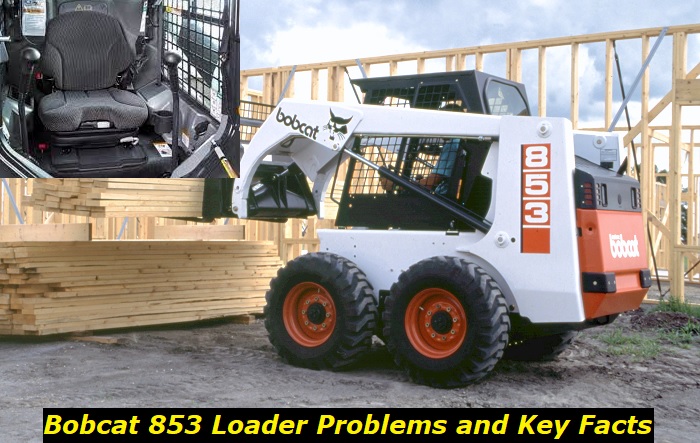Bobcat 853: Problems, Durability, Repairs
Although the Bobcat 853 is quite an old skid-steer loader, this is the legend of the company and is still available on the market of used equipment. The loader is efficient and compact, it can solve a lot of different tasks without taking a lot of money out of the company's budget. That's why, between 1990 and 1996, this was one of the most popular compact loaders.
Today, we'll tell you about some of the most common problems with the Bobcat 853 and will also reveal important specs and features. So, if you are going to buy such a loader, you'll be perfectly aware of what may be waiting for you. Also, we'll look at the potential longevity of the loader and see if it's still a good purchase.

Here's what we'll be talking about:
- What are the key features of the Bobcat 853?
- How many hours should the skid-steer loader survive?
- What are the common problems with the 853 model?
- What should you know to keep using this equipment longer?
Let's get started!
Key facts about the Bobcat 853 you should know
So, the last Bobcat 853 left the production site in 1996. But still, a lot of these machines are still working in different parts of the world. What's more, people keep being interested in this equipment and buy it used. That's why we've decided to write this article to show you both advantages and drawbacks this machine may have.
The 853 is a compact machine that travels on four wheels. The axles are located extremely close to each other which makes these wheels act just like tracks in many cases. Also, the wheels are pretty big for the size of the loader - this allows the machine to show wonderful off-road capabilities. Also, wheels are easier to maintain than tracks.
Here are some of the key features of the Bobcat 853:
- the loader is powered by a relatively small diesel engine with 52 horsepower, the torque is pretty high to let the equipment do the job;
- the operating capacity of 1700 lbs doesn't seem extremely good, but just compare it with other loaders of that epoch;
- the tipping load seems to be better with 3420 lbs which is pretty great for this machine;
- the travel speed of 6.2 mph often makes companies search for options to transport the loader with some other means to the place of work;
- the 25-gallon fuel tank seems to be enough for the economical diesel engine;
- hydraulic system is pretty classical for that period and appears to be very reliable and long-lasting;
- the key advantage of the machine is its turning radius which is just 76 inches - it seems to be able to go anywhere;
- the Bob-Tach attachment system allows owners to use more or less any Bobcat attachments with this skid-steer loader;
- the machine has DPF which is good for ecology but bad for your budget, especially now, that the equipment is old.
It's a compact loader that offers all the advantages of most Bobcat models. It's small but really tough and can do any kind of job. Of course, it's not recommended to use loaders of this kind inside warehouses without proper ventilation. Any diesel-powered equipment should be only used outside.
The model was also originally equipped with an anti-burglar system. Unfortunately, we have no information on whether it's an efficient system or not. But given we haven't found any reports on forums, we believe it works well. Or at least, it doesn't bother owners with its glitches like in some other compact loaders.
How long will the Bobcat 853 last?
The average durability of the 853 model is really good. We believe these skid-steer loaders are able to work for 7,500 hours with only minor problems popping up there and then. After this hour limit is achieved, the loaders may show more serious and expensive-to-solve problems. The Bobcat 853 model is not cheap to maintain and repair, so sometimes, it's really wise to replace the machine when it has more than 7.5 thousand hours on it.
But we know cases when companies successfully used these models of loaders for up to 10K hours and had no serious problems with them. Of course, it all depends on many factors such as quality of maintenance, conditions of use, ways to store the loader when not used, etc. All these factors influence the durability and reliability of the machines.
What are the common problems with the 853 compact loader?
We could find a lot of problems that may be called common by just searching through the forums. But we should also say that the model is pretty old and most of its problems are because of its age and a lot of hours on it. So, we'll try to focus on the problems that are significant for potential buyers of these machines.
So, here are the 5 issues you should pay attention to:
1. The old age of any available loader
Unfortunately, these machines haven't been manufactured for almost 20 years now, so the youngest ones are about 20 years of age. And this can cause all sorts of problems with hydraulics, engines, body parts corrosion, etc. Also, if a loader has been used a little and stored in a proper place, it can still be a really reliable machine.
But you should pay attention to the hours. Even a relatively young piece of equipment with a lot of hours on it is a bad purchase. Given we are dealing with old loaders, hours are extremely important. Paying for a loader that has more than 5K hours is really risky because you may get a dead machine requiring a lot of investment.
2. Diesel engine problems
Old diesel engines are rarely reliable. They can surprise you with a number of minor issues with fuel supply, injection, engine temperature, head problems, etc. Even though this engine is not powerful at all, it still can fail because of the relatively small displacement and high torque. Major parts of the engine are under bad load and can fail once something goes wrong with the temperature, fuel quality, etc.
Engine problems are very common but are also pretty easy to solve. This is not a highly technological engine with extremely expensive parts. The technology is really simple, so any engine mechanic can solve your problems really fast and without huge bills.
3. Seals and gaskets problems
Hydraulics may fail too often now because of the age of the machine. Gaskets, O-rings, and seals tend to dry and stop doing their job correctly. It leads to leaks, loss of fluids, overheating, faulty hydraulics, and inability to complete some tasks.
Even though these problems may seem major and expensive to solve, the issues are actually cheap and not so hard to locate and repair. Parts may be the problem as there are fewer options now on the market than before.
4. DPF problem
One more issue worth mentioning is the problem with the DPF - diesel particulate filter. If you own this machine, you probably know about DPF cleaning issues. If the machine often works at low RPM, the DPF may be clogged very fast. And while there is the regeneration option, it doesn't always help deal with problems.
Replacing the DPF is extremely expensive, so you should know for sure how to use your equipment to avoid DPF problems.
5. Controller problems
This problem also comes from the age of the machine. Malfunctioning controls may be the worst thing you experience in a loader. The problem usually develops because of wiring issues. The controls are reliable but wires and connections aren't eternal.
If you experience problems with controlling everything your skid-steer loader does, take the Bobcat 853 to the specialist who can check wiring and other possible issues with controls. Usually, this is the hardest-to-locate issue and it requires some time to be repaired.
What should you know to keep using your Bobcat 853 model longer?
The durability of a certain skid-steer loader doesn't always depend on maintenance only. Sometimes, harsh conditions of work make a loader live much less than its owner may expect. But if the conditions are average, here are some things you should remember:
- maintain your loader just as the manufacturer recommends;
- avoid using cheap aftermarket parts of bad fluids for repair and maintenance;
- keep your loader away from bad mechanics;
- pay attention to any minor issues and address them seriously and immediately;
- avoid overheating and other destructive mishaps;
- have the loader inspected at least twice a year;
- learn how you should store the machine if you aren't going to use it for a long time;
- always check if your operator has enough skills and experience to safely operate the equipment.
Final words
We know that the old skid-steer loader is not the best thing for someone's business. But sometimes companies just have little money and they still need to solve their problems with equipment. In this case, the 853 model from Bobcat doesn't seem like a bad choice. Just learn what kinds of problems it may have so that you were ready for possible mishaps and could address them properly.

Add comment